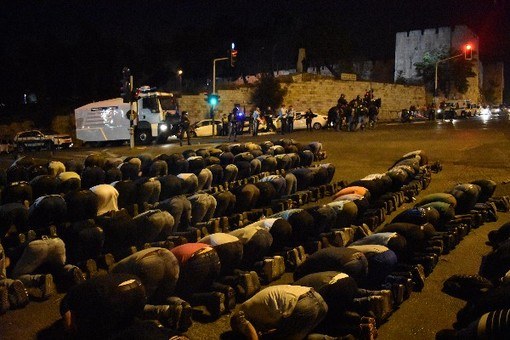
People praying in Jerusalem, as Israeli soldiers watch. Photo: Richard Hardigan.
On July 23, The New York Times, CNN and ABC News all employed the word “clashes” to describe the events that took place in Jerusalem and the West Bank over the past few days. The Oxford English Dictionary describes a clash as a violent confrontation. The connotation is that the conflict is occurring between two or more parties, and they are all actively involved. An elephant crushing a mouse would not be considered a clash, because only the former is an active participant.
When the Israeli authorities imposed heavy restrictions on Palestinian access to Al Aqsa mosque, the holiest Islamic site in Palestine, in the wake of the shootings that occurred in Jerusalem on Friday, July 14, it affected Palestinians in Jerusalem and all over the West Bank.
On Friday, July 21, there was an organized effort to pray the noon Friday prayer at the Qalandiya checkpoint near Ramallah as a form of non-violent protest. The prayer began peacefully, but after a few minutes the Israeli forces, who had gathered in front of the checkpoint, fired a heavy barrage of teargas at the worshippers.
“Did you see that?” an old man asked me. “We were just praying. They don’t let us pray at Al Aqsa. And now they don’t let us pray at Qalandiya.”
The teargas forced the worshippers to retreat about a hundred meters, where they once again began to pray. This, in turn, caused the army to fire more teargas. This process repeated itself several times.
“There are no clashes today,” a young boy told me. “We are only here to pray.”
“They must be so afraid of us, if they shoot at us when we are only praying,” another man said.
The situation was similar in Jerusalem on Friday evening, where worshippers prayed in the alleyways of the Old City and near Lion’s gate because of the restrictions. Eventually, the army forced the worshippers even farther away, outside the road that leads to Lion’s gate. There they laid out their prayer rugs and performed their prayers as the heavily armed soldiers looked on. No stones were thrown, and there was no violence, except for the teargas and rubber bullets employed by the Israelis. The scene repeated itself on Saturday evening, where on this occasion the soldiers added horses and water trucks to their arsenal.
There were situations where the violence of the Israeli army was indeed met with the throwing of stones. But that was far from the norm. The media’s representation of the events as clashes – confrontations between parties – does a great disservice to the interests of both